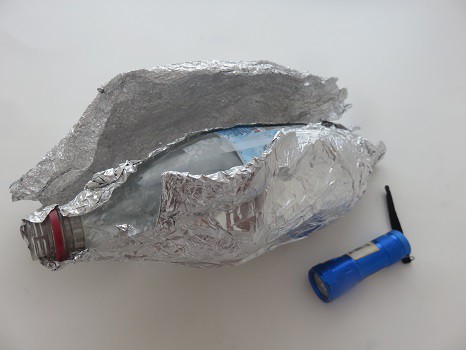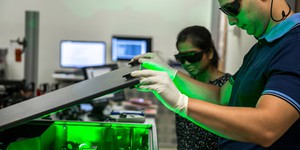Summary

Introduction
Light is fascinating! It can look like a wave or a particle; it can be red, blue or any color of the rainbow; you can even mix all the colors together to get white! It travels in straight lines and still appears to bend around objects. It can travel through air, but it does not need the air. Unlike sound, light can travel from distant stars through a vacuum and reach us years later, or it can be sent through fiber optic cables and go around the world in less than a second! Does that sound impressive? How about pouring light from a bottle into a glass or sink? Does this sound too far-fetched to you? Try the activity and make it happen!
Background
Have you ever noticed how you need to point a flashlight toward an object illuminate the object? That shows that light travels in straight lines. But, what if we introduce a mirror, or shine a light beam into water? Light bouncing off a shiny surface (in other words, reflected by the surface) or light bent when entering a medium (meaning refracted on the surface) introduces kinks into these straight lines. Several activities listed in the “Explore More” section can help you understand these phenomena better.
In this activity, you will look at what happens when light inside a body of water reaches the water surface. Light falling nearly perpendicular on a water-air surface pierces through the surface; that is why we call water ‘translucent.’ But did you know that water also reflects part of the light? It almost acts like a mirror for light hitting it at small angles with the water’s surface. It is this reflective nature of a water-air surface that allows us to trap light in a beam of water. When light initially hits the water beam boundary at a small angle, it keeps hitting the boundary at small angles and gets reflected over and over again. It can almost not escape to a less dense medium, like air. This is called total internal reflection and explains how light gets trapped inside a beam of water.
Materials
- Flashlight
- Empty colorless, transparent soda bottle. A 1 liter bottle works well.
- Aluminum foil
- Water
- Dark room
- Sink or tub in the dark room
Preparation
- Attach the flashlight to the base of the transparent empty soda bottle so that, when turned on, the light shines straight into the bottle, toward its neck.
- Wrap the bottle and flashlight in aluminum foil. Make sure you can still reach the on/off button of the flashlight. Wrap the bottle to the rim, but leave the bottle opening unpacked so you can still fill the bottle.
- Find a room that can be darkened, that also has a sink or tub from which you can easily pour water.
Instructions
- Proceed to the room that can be darkened.
- Fill the prepared bottle with water
- In a moment, you will turn on the flashlight and turn off the light. What do you expect to see? Will the bottle glow? Will only the opening near the top glow? Do you expect the beam of light to illuminate the room, make a circle on the ceiling or not do much?
- Turn off the light and observe. Was your prediction correct?
- In a moment, you will pour out the contents of the bottle into the sink or tub. Do you expect to see anything special?
- Tilt the bottle so water flows in a fluid arch into the sink or tub. Turn on the light briefly if you need to check where you can pour the water. Observe where the light goes. Does the light travel in a straight line to illuminate the back of the sink, does it follow the beam of water to illuminate the bottom of the sink, or does nothing much get illuminated? Is the beam of water glowing or hardly visible in the dark?
- As the water runs out, observe where the light beam hits the sink or tub now. Is it at a different spot? Why?
Extra: If you have a laser pointer available, repeat the activity with the laser pointer. Be careful though; never look into the light produced by a laser or let the light bounce back from a reflective material into your eyes! Before you repeat the activity with your laser pointer, explore the differences between the light produced by a laser and the light produced by your flashlight. How are they different; how are they similar? How could these differences influence what you observed in this activity? Did the activity confirm or refute your predictions?
Extra Optical fibers are flexible strands of glass. They are used to transport pulses of laser light (carrying information) over long distances. The light does not smoothly bend with the cable, but hits the wall of these fibers frequently. Each time the light hits the wall, it gets reflected back into the fiber. As long as you do not bend the fiber sharply, the laser light stays trapped in the cable all the way until the end of the cable. Can you detect similarities between the activity and optical fiber cables? Could you find ways to transmit information in your water beam, and if so, how?
Observations and Results
Did you notice how, at first, the light illuminated the spot on the ceiling or the wall where the bottle was pointing to? Were you surprised to see how the light followed the beam of water when you poured the water? This is what is expected.
Initially, when you are holding the water bottle up, light emitted by the flashlight hits the water surface nearly perpendicular. In this case, light can easily move through the water-air surface and travel straight on to illuminate a spot on the ceiling or wall. Conditions change when you tilt the bottle and pour water out. Now, light hits the water surface at a small angle. In this case, the water-air surface reflects the light back into the water like a mirror would do. The reflected light travels on and encounters the water boundary again, at a different spot, but again at a small angle and again, it is reflected back. Time after time, the light gets reflected at the edge of the water beam. It is trapped inside the water beam and follows the path of the water, only to be released when the water hits the sink or tub. There, light is reflected in all directions. You observe a brightly illuminated spot.
Light travels through optical cables in a similar way, continuously bouncing off the edges of the cable as it makes it way to the end of the cable, where it can release its information.
Ask an Expert
Additional Resources
- Now You See It...Testing Out Light Refraction, from Scientific American
- Double-Split Science: How Light Can Be Both a Particle and a Wave, from Scientific American
- Can You Create an Infinite Number of Reflections, from Scientific American
- Colored shadows, from Scientific American
- Bending of light | Laser bending demonstration, from Elearnin







